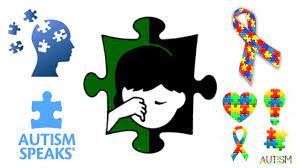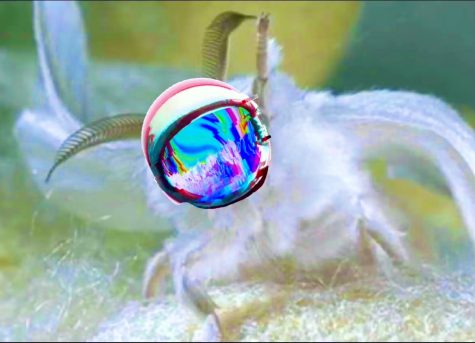Autism symbolism needs to change
Why you shouldn’t use the puzzle piece

May 17, 2023
Autism. Chances are you know at least one person who has it. There’s also a chance that you’ve wanted to show support for this person. Whether that be via a pin, shirt, hat, whatever, you’re trying to show your loved one how much you care. So, you go online to find something and upon doing so, you discover the absolute eyesore that is autism merchandise: clashing colors, “AUTISM WARRIOR” printed in an appalling font, and designs so hideous it could send someone into a coma. Like seriously, how are these real? If you were to look up autism merchandise, you’d notice the colorful puzzle pieces are a common theme across many items. This symbol has become synonymous with autism, despite many autistic people stating that it is offensive or problematic. What makes this symbol so controversial?
The birth of the puzzle piece/autism connection was in 1963 when The National Autistic Society adopted a new logo. This logo featured a puzzle piece divided into a green half and a black half with a young boy crying in the middle. According to the Sarah Dooley Center For Autism, the puzzle piece was incorporated as a result of people finding autism to be a “puzzling condition.” The idea behind it was that this mysterious disorder had stolen a piece of their child. The crying little boy in the middle was meant to symbolize how autism was a boy’s condition and how it was making his life miserable.
Throughout the years, the puzzle piece has stayed while other elements were left behind. However, the beliefs behind the original symbol have stayed attached to these new adaptations, and as time goes on and our medical practices progress, these beliefs only become less believable.
According to NIMH, autism (or autism spectrum disorder) is a neurological and developmental disorder that affects how people interact with the world around them. There’s nothing puzzling about that. It’s not mysterious or sneaky; it’s not lurking around the corner waiting to jump out and nab you; it’s just a difference in neurological development. It’s also definitely not just a boy’s condition.
When the criteria for autism was being developed, scientists were using data they had gathered by monitoring children they believed had autism. This research however was skewed, as the people they were monitoring were almost exclusively male children. As a result, only male patients, typically children, got diagnosed. This practice morphed into an unwillingness to diagnose female patients with autism. The Massachusetts Institute of Technology actually ran a study in which they found that our way of diagnosing people with autism unequally affected female participants, resulting in a void where research for autistic women should be. The only piece puzzling about autism is why women are less likely to get diagnosed.
The idea that autism makes those affected by it miserable is rooted in opinions of those that do not have autism. Many parents have described their children’s autism as having stolen their freedom as parents.
Autism Every Day is a well known video that many in the autistic community have stated to be extremely harmful to the community. In this video, you’ll see autistic children in distress, and their parents doing nothing to soothe them. You’ll also hear the words of multiple mothers who have almost nothing positive to say about their kids. One mother in the video states, “I didn’t choose to do this. I’m not a therapist. I was drafted.” Like it was her versus autism and not her child versus a world that can be very uncomfortable to live in.
Another mother described a horrifying thought she had: “I sat in the car for about 15 minutes and actually contemplated putting [her child] in the car and driving off the George Washington Bridge..,” she states with her child directly behind her. She then goes on to say that the only reason she didn’t do it was because she had another child who wasn’t autistic that she couldn’t imagine leaving behind.
The kids in this video aren’t in pain because they have autism, they’re in pain because their parents aren’t providing them with the care they need. The mothers in this video made their child’s autism exclusively about how it affects them as mothers. Their intolerance is thinly veiled as a sorry excuse for sympathy. This video and other videos like Autism Speaks’s I Am Autism do a terrible job of portraying autism as what it really is, a condition. Autism is not a disease, nor a personality that kids put up to inconvenience their parents, an unchangeable condition.
If you decide you want to have a child, whether you like it or not, you are signing up to have a child with a disability. There’s no guarantee your child is going to be born as this non-disabled.
Organizations like Autism Speaks are not friends to autistic people. Throughout the years, organization after organization has told them that they need to be cured. They have run inhumane tests, experiments, studies, in search for a fix. They hide their intentions behind big words and beat-around-the-bush statements like “improve quality of life” when their actions have proven to do anything but.
Only one percent of Autism Speaks‘ profit goes to families of autistic people. Their board of directors only includes a singular autistic person out of 28 board members. On their website they claim that they aren’t searching for a cure anymore, then they choose to not link the DNA repository they fund. The DNA repository (AGRE) was founded by the organization Cure Autism Now, and the information detailed describes “flags for possible non-idiopathic autism,” most of which can be detected while a fetus is still developing. They were perfectly willing to link MSSNG, their other research branch that didn’t contain information like this. Are they trying to make sure no one peaks behind the curtain? Because, that’s what it looks like.
From the National Autistic Society to Autism Speaks to countless other organizations, the same principles, ideas, and beliefs prevail. Female autistic people still aren’t getting diagnosed, hardly anyone is properly informed about autism, and parents are still crying for the loss of their “normal child.” Autism is still seen as a puzzle piece missing from the picture. If you want a symbol made by autistic people that symbolizes them and not the outdated and unappreciated ideals of the past, the rainbow infinity loop is a good option. It represents the connection all autistic people have and how autistic people exist on a spectrum. Not to mention, most versions of this symbol have colors that aren’t so saturated that it’ll give you a headache.
Just please, for the love of autistic people, ditch the puzzle piece.




Robin Perry | Sep 28, 2023 at 10:13 pm
Very well written and thought provoking.
Charlie | May 18, 2023 at 9:01 am
Super powerful piece regarding autism. Thank you for writing it. Down with the puzzle piece!